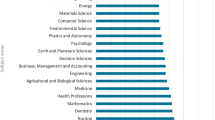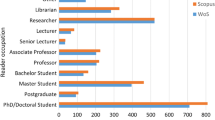Abstract
This paper presents a large-scale study of the phenomenon ‘uncitedness’. A literature review indicates that uncitedness is related to at least three factors: Field, document type, and time. To explore these factors and their mutual influence further, and at much larger scale than previous studies, the paper focuses on seven subject areas (arts and humanities; social sciences; computer science; mathematics; engineering; medicine; physics and astronomy), seven document types (articles; reviews; notes; letters; conference papers; books; book chapters), and a 20-year publication window (1996–2015). Documents are searched in Scopus, and retrieved year-by-year, discipline-by-discipline, and for each individual document type (total: 29,472,184 documents; 7,508,741 uncited documents). The results show great variance in uncitedness ratios between subject areas and document types. This is probably caused by a somewhat tacitly agreed upon genre hierarchy existing in all subject areas, yet with important local traits and differences. The importance of the time-dimension is documented. Time to first citation varies a great deal between subject areas, and the uncitedness ratio is consequently shown to be quite sensitive to the length of citation windows.




Similar content being viewed by others
Notes
Article, letter, note and review were searched as DOCUMENT TYPE and further limited to SOURCE TYPE: Journal. Conference paper was searched as DOCUMENT TYPE and further limited to SOURCE TYPE: Conference proceeding. Book and book chapter were searched as DOCUMENT TYPE with no further limitation.
References
Arsenault, C., & Larivière, V. (2015). Is paper uncitedness a function of the alphabet? Paper presented at the 15th international society of scientometrics and informetrics conference, ISSI 2015.
Becher, T. (1989). Academic tribes and territories. Buckingham: Open University Press.
Burrell, Q. L. (2012). Alternative thoughts on uncitedness. Journal of the American Society for Information Science and Technology, 63(7), 1466–1470.
Burrell, Q. L. (2013). A stochastic approach to the relation between the impact factor and the uncitedness factor. Journal of Informetrics, 7(3), 676–682.
Burton, R. E., & Kebler, R. W. (1960). The “half-life” of some scientific and technical literatures. American Documentation, 11(1), 18–22.
Cuenca, A. M. B., Barbosa, M. M. A. L., Oliveira, K., Quinta, F., Alvarez, M. D. C. A., & França, I. J. (2017). Uncited articles in Brazilian public health journals. Revista de Saúde Publica, 51, 114.
Drott, C. M. (1995). Reexamining the role of conference papers in scholarly communication. Journal of the American Society for Information Science, 46(4), 299–305.
Egghe, L. (2013). The functional relation between the impact factor and the uncitedness factor revisited. Journal of Informetrics, 7(1), 183–189.
Egghe, L., Guns, R., & Rousseau, R. (2011). Thoughts on uncitedness: Nobel laureates and fields medalists as case studies. Journal of the American Society for Information Science and Technology, 62(8), 1637–1644.
Frandsen, T. F., & Nicolaisen, J. (2017). Rejoinder: Nobel Prize effects in citation networks. Journal of the Association for Information Science and Technology, 68(12), 2844–2845.
Garvey, W. D., & Griffith, B. C. (1972). Communication and information processing within scientific disciplines: Empirical findings for Psychology. Information Storage and Retrieval, 8(3), 123–136.
Garvey, W. D., Lin, N., Nelson, C. E., & Tomita, K. (1972). Research studies in patterns of scientific communication: II. The role of the national meeting in scientific and technical communication. Information Storage and Retrieval, 8(4), 159–169.
Gopalakrishnan, S., Gopalakrishnan, S., Bathrinarayanan, A. L., & Tamizhchelvan, M. (2015). Uncited publications in MEMS literature: A bibliometric study. DESIDOC Journal of Library and Information Technology, 35(2), 113–123.
Hamilton, D. P. (1990). Publishing by-and for?-the numbers. Science, 250, 1331–1332.
Hamilton, D. P. (1991). Research papers: Who’s uncited now? Science, 251, 25.
Hargens, L. L., & Bott, D. M. (1991). Letter to the editor. Science, 251, 1409.
Heneberg, P. (2013). Supposedly uncited articles of Nobel laureates and Fields medalists can be prevalently attributed to the errors of omission and commission. Journal of the American Society for Information Science and Technology, 64(3), 448–454.
Ho, Y. S., & Hartley, J. (2017). Sleeping beauties in psychology. Scientometrics, 110(1), 301–305.
Hsu, J. W., & Huang, D. W. (2012). A scaling between impact factor and uncitedness. Physica A: Statistical Mechanics and Its Applications, 391(5), 2129–2134.
Hu, X. J., & Rousseau, R. (2013). Meeting abstracts: A waste of space? Current Science, 105(2), 150–151.
Hu, Z., & Wu, Y. (2014). Regularity in the time-dependent distribution of the percentage of never-cited papers: An empirical pilot study based on the six journals. Journal of Informetrics, 8(1), 136–146.
Hyland, K. (2000). Disciplinary discourses: Social interactions in academic writing. Harlow: Pearson Education Ltd.
Kamat, P. V. (2018). Most cited versus uncited papers. What do they tell us? ACS Energy Letters, 3(9), 2134–2135.
Koenig, M. E. (1983). Bibliometric indicators versus expert opinion in assessing research performance. Journal of the American Society for Information Science, 34(2), 136–145.
Law, R., Lee, H. A., & Au, N. (2013). Which journal articles are uncited? The case of the Asia Pacific Journal of Tourism Research and the Journal of Travel and Tourism Marketing. Asia Pacific Journal of Tourism Research, 18(6), 661–684.
Li, J. (2013). Uncited SSCI publications in China. Current Science, 104(11), 1462–1463.
Liang, L., Zhong, Z., & Rousseau, R. (2015). Uncited papers, uncited authors and uncited topics: A case study in library and information science. Journal of Informetrics, 9(1), 50–58.
Liu, L., & Danziger, R. S. (1996). Fate of conference abstracts. Nature, 383, 20.
Lou, W., & He, J. (2015). Does author affiliation reputation affect uncitedness? Proceedings of the Association for Information Science and Technology, 52(1), 1–4.
Mackenzie, I. S. (2009). Citedness, uncitedness, and the murky world between. Paper presented at the 27th international conference extended abstracts on human factors in computing systems, CHI 2009, Boston, MA.
Mavrogenis, A. F., Quaile, A., Pećina, M., & Scarlat, M. M. (2018). Citations, non-citations and visibility of International Orthopaedics in 2017. International Orthopaedics, 42(11), 2499–2505.
Nane, T. (2015). Time to first citation estimation in the presence of additional information. In A. Salah, Y. Tonta, A. A. A. Salah, & C. Sugimoto (Eds.), Proceedings of the 15th international society of scientometrics and informetrics conference (ISSI-2015) (pp. 249–260). Istanbul: Bogazici University Printhouse. ISBN: 978-975-518-381-7.
Pendlebury, D. A. (1991). Letter to the editor. Science, 251, 1410–1411.
Price, D. J. D. S. (1965). Networks of scientific papers. Science, 149(3683), 510–515.
Rosenberg, P. (2000). Chardin. London: Royal Academy of Arts.
Rosenkrantz, A. B., Chung, R., & Duszak, R., Jr. (2018). Uncited research articles in popular United States general radiology journals. Academic Radiology, 1, 11. https://doi.org/10.1016/j.acra.2018.04.011.
Sen, R., & Patel, P. (2012). Citation rates of award-winning ASCE papers. Journal of Professional Issues in Engineering Education and Practice, 138(2), 107–113.
Swales, J. M. (2004). Research genres: Exploration and applications. Cambridge: Cambridge University Press.
Tahmasebi, S., Foroughi, Z., & Alizadeh-Navaei, R. (2017). Comparing the levels of non-citation of Iranian journals on health in Persian and English in scopus database. Journal of Mazandaran University of Medical Sciences, 26(146), 165–172.
Tang, R. (2008). Citation characteristics and intellectual acceptance of scholarly monographs. College and Research Libraries, 69(4), 356–369.
Thelwall, M. (2016). Are there too many uncited articles? Zero inflated variants of the discretised lognormal and hooked power law distributions. Journal of Informetrics, 10(2), 622–633.
van Dalen, H. P., & Henkens, K. (2004). Demographers and their journals: Who remains uncited after ten years? Population and Development Review, 30(3), 489–506.
van Leeuwen, T. N., & Moed, H. F. (2005). Characteristics of journal impact factors: The effects of uncitedness and citation distribution on the understanding of journal impact factors. Scientometrics, 63(2), 357–371.
van Raan, A. F. (2015). Dormitory of physical and engineering sciences: Sleeping beauties may be sleeping innovations. PLoS ONE, 10(10), e0139786. https://doi.org/10.1371/journal.pone.0139786.
Wallace, M. L., Larivière, V., & Gingras, Y. (2009). Modeling a century of citation distributions. Journal of Informetrics, 3(4), 296–303.
Watson, J. D., & Crick, F. H. C. (1953). Molecular structure of nucleic acids: A structure for deoxyribose nucleic acid. Nature, 171, 737–738.
Yamashita, Y., & Yoshinaga, D. (2014). Influence of researchers’ international mobilities on publication: A comparison of highly cited and uncited papers. Scientometrics, 101(2), 1475–1489.
Zhao, S. X. (2015). Uncitedness of reviews. Current Science, 109(8), 1377–1378.
Author information
Authors and Affiliations
Corresponding author
Rights and permissions
About this article
Cite this article
Nicolaisen, J., Frandsen, T.F. Zero impact: a large-scale study of uncitedness. Scientometrics 119, 1227–1254 (2019). https://doi.org/10.1007/s11192-019-03064-5
Received:
Published:
Issue Date:
DOI: https://doi.org/10.1007/s11192-019-03064-5




